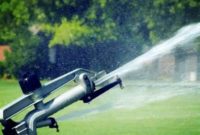You waited all winter for the snow to melt and ice to thaw so you can get started on your garden and lawn. You’ve read some books, checked the Internet and you’re ready to get started. But first, you need to decide what type of watering system you’ll use.
When choosing a watering system, there are a number of factors to consider. As we become more and more conscientious about water conservation, we ask that you think about these factors when choosing your sprinkler system.
Begin by choosing a system that places large drops of water close to the ground or underground, as they are the most efficient type of sprinkler – certainly more efficient than sprinklers that spray water (even a mist) and lose water due to evaporation.

Knowing what types of flowers and plants you want in your garden will help you make good selections on sprinkler systems as you’ll know how much water these plants require and how often. Also, try to hydrozone, which simply means placing plants with similar watering needs together.
A number of systems are focused on efficiency. Here are some of the most popular irrigation on your garden and lawn :
- Soaker Hoses – soaker hoses ooze water through a porous membrane running the length of the hose. They are great for deep watering as gardeners may bury them along the roots and watering lines of the garden or plants. They are relatively easy to employ and allow you to customize your watering system as timers and regular hoses can be attached to soaker hoses to ensure water is shared only where it’s needed.
- Drip Irrigation Systems – Drip Irrigation Systems are becoming the most popular among landscapers and irrigators as they are the most water-efficient. They are especially good for non-turf areas. Each drop is applied slowly and allowed to soak into the ground. This system uses a fraction of the water that overhead spray devices use. It’s also quite easy to add, reduce or change the location of the sprinkler or drippers. Additionally, drip irrigations systems are easy to administer on a zone system.
- Spray Systems – This traditional form of sprinkler uses spray heads, some at ground level, some pop ups and some on extended, exterior pipes. These spray heads come in different shapes and functions spraying a full circle, a half circle or different fractions of a circle. Spray systems are most commonly used on small areas: turf, shrubs or flowerbeds. They are best made for flat surfaces and tend to waste more water than other systems. Gardeners must take care with spray systems not to overwater as they often unknowingly leave spray systems on too long either overwatering plants or creating run-off by dumping too much water faster than the ground can absorb it.
- Rotor Systems – although generally more efficient than spray heads, these systems lose quite a bit of water to evaporation as well. Rotor systems come in two main styles: stream or impact. They are useful in covering large areas and typically apply water more uniformly than spray heads. However, they do move the focus of the water enough to give drops time to be absorbed by the ground, plants and flowers.
Knowing the rate at which your sprinkler system applies water (application rate) and assuring that this application is as uniform as possible is essential to proper watering and water conservation.
We recommend you research what you think works best, then allow a certified contractor to give you feedback and an estimate for installation.
